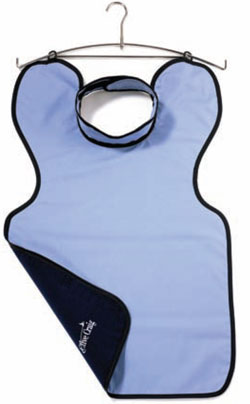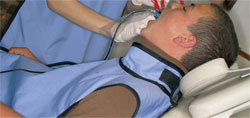DUX Dental’s Xenolite® Lead-Free Apron
When referring to current dental radiography, the benefits of using digital radiographs versus film radiographs as well as which digital sensor delivers a superior image are always among the topics discussed.1 One topic that receives very little attention despite some major breakthroughs is protection from radiation exposure.
Digital radiographs do offer the advantage of using less radiation than traditional film-based radiographs. However, there will always be variations in the amount of radiation necessary to capture an image depending on the location of the tooth in the mouth, density of the bone, thickness of the cheek, etc. Some authors have noted that there is a common belief that all digital radiography systems reduce radiation exposure compared to film,1,2 but this is not always the case.
Therefore, dentists and their assistants bear responsibility for the efficient use of diagnostic radiation.3 Naturally, that responsibility extends to protecting patients and ensuring their comfort when conducting radiographic examinations.
Conventional Protection Against Radiation Exposure
Leaded aprons have traditionally offered dental patients and office staff protection from secondary (scatter) radiation during intraoral or panoramic radiography procedures. However, these aprons are stiff, heavy, and awkward to use. For example, when placed over the patient, they slip and do not properly conform to the body and the thyroid collar does not adapt well around the neck. The vinyl covering is cold, uncomfortable, and tends to lose its resiliency and crack over time. Additionally, lead is now a known environmental and health hazard.
The Xenolite Lead-Free Apron Alternative
To enhance patient protection from radiation exposure and increase comfort during the radiography process, lead-free aprons from DUX Dental (Oxnard, CA) are now available (Figure 1). They feature a technologically advanced, uniformly thin alloy sheet called Xenolite®, which was developed by DuPont (Wilmington, DE) and is available exclusively through DUX Dental.
Constructed with a fracture-resistant, microfiber front, non-slip Scotchgard® (3M, St. Paul, MN) corduroy back and binding, the DUX Dental lead-free aprons have demonstrated the same attenuation (ie, drop in transmission) of x-radiation as leaded radiography aprons. However, the DUX Dental Xenolite apron weighs approximately 30% less than conventional aprons and is safer for patients and operators because it is lead-free.
The lead-free aprons are availablein blue or gray microfiber in 3 styles (with or without a thyroid collar or a panaoramic poncho).
Easier and More Comfortable to Use
Because the Xenolite apron features a nonslip corduroy backing, assistants and technicians no longer have to interrupt radiography procedures to reposition the apron to ensure proper coverage. The apron demonstrates a supple, flexible texture that is readily and easily adaptable to all body types, thereby enhancing the ergonomic and comprehensive nature of its use, even for pediatric and geriatric patients.
Unlike a leaded apron with a thyroid collar, the lead-free Xenolite apron with a soft thyroid collar is easy to adapt to all neck sizes, allowing for greater coverage of the apron around the neck and thyroid area (Figure 2). Studies have proven the radiosensitivity of the thyroid gland, making it an organ of concern in dental radiography.4 Therefore, this comfort and protection feature is particularly beneficial for all patients.
Additionally, the lighter weight and more pleasing appearance of the Xenolite lead-free apron contributes to greater patient comfort by helping to alleviate anxiety, especially in situations where patients may feel vulnerable.5 Such feelings can be intensified by a sense of depersonalization that results from the need to use barrier precautions,5 including radiography aprons.
Proven Protection
The efficacy of the DUX Dental Xenolite lead-free apron has been proven by 2 renowned physicists affiliated with University of Southern California and the University of California, Los Angeles. Tests conducted at each respective location proved that the Xenolite aprons attenuate radiation equivalent to a leaded apron. Additionally, the DUX Dental lead-free apron provides the same level of protection throughout the garment as a result of its uniform alloy sheeting, which is directly associated with the Xenolite manufacturing process. Conversely, leaded aprons are subject to manufacturing variations that could result in different levels of attenuation in the same garment.
Care and Maintenance
Regular cleaning and maintenance of the DUX Dental lead-free apron is more efficient than conventional leaded aprons. Because the microfiber front is durable and will not crack like a vinyl apron, it can be easily wiped down with and readily withstand most disinfectant liquids. The corduroy backing is treated with Scotchgard for additional stain resistance.
When handled according to the manufacturer’s instructions, the lead-free apron demonstrates a longer life expectancy than conventional leaded aprons. Therefore, although it might be tempting to fold or bend the apron given its flexibility, this is not recommended. Folding or bending the apron may cause the Xenolite to fatigue and compromise its protective qualities. Instead, the lead-free apron may be suspended lightly from its hanger, either by loops on the edge of the standard apron, or draped over the hanger, as in the case of the panoramic apron. Additionally, the materials used in the DUX Dental lead-free aprons are 100% recyclable.
Conclusion
When new technologies—such as digital radiography—are considered for the dental practice, clinicians should not lose sight of other advancements that can make implementation safer for patients. The lighter weight and proven protection from the DUX Dental Xenolite lead-free apron enables dental practices to further enhance the comfort and protection they provide to their patients during radiography procedures. Its use during day-to-day radiography examinations demonstrates an elevated level of care and respect for patients by ensuring their comfort while simultaneously protecting them from potential radiation exposure.
References
1. Kutsch VK. Important considerations when evaluating digital radiography systems: image quality, specifications, and the ALARA principle. Inside Dentistry. 2005;1(2):36-37.
2. Kiefer H, Lambrecht JT, Roth J. Dose exposure from analog and digital full mouth radiography and panoramic radiography. Schweiz Monatsschr Zahnmed. 2004;114(7):687-693.
3. Laws PW. How patients view the efficient use of diagnostic radiation. Radiol Technol. 1976;47(4):245-249.
4. Bristow RG, Wood RE, Clark GM. Thyroid dose distribution in dental radiography. Oral Surg Oral Med Oral Pathol. 1989;68(4): 482-487.
5. Levin RP. Helping your patients overcome dental phobia. Compend Contin Educ Dent. 2003 Jan;24(1):8, 10.
This article was written by Tony Soileau, DDS
For More Information
DUX Dental
Phone: 1-800-833-8267
E-mail: duxoffice@duxdental.com
Web: www.duxdental.com
 |  | |
| Figure 1 The lead-free apron from DUX Dental features a technologically advanced, uniformly thin alloy sheet called Xenolite®. | Figure 2 The apron is shown here with a soft thyroid collar, which is easy to adapt to all neck sizes, allowing for greater coverage of the apron around the neck and thyroid area. |



